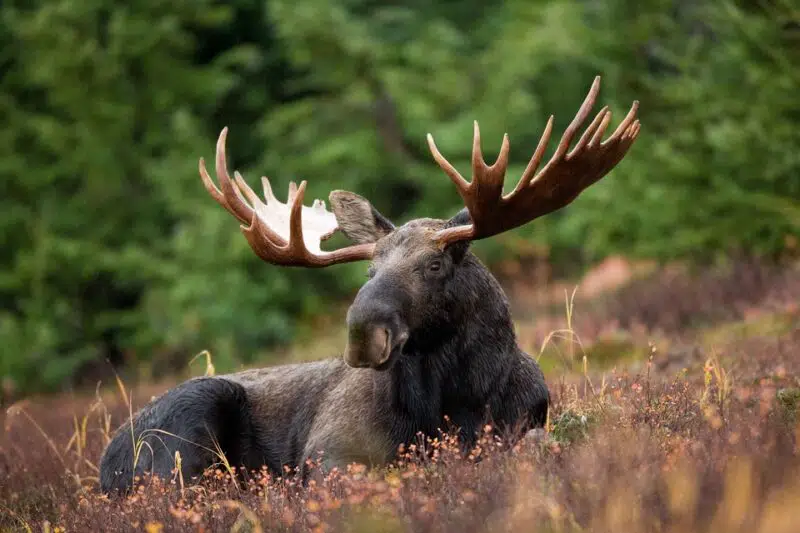Welcome to the enchanting world of Animals and Wildlife in Arkansas! Arkansas, fondly known as “the Natural State,” boasts a remarkable blend of natural beauty that will surely leave you awe-inspired. This vibrant state is flanked by the magnificent Ozark Mountains on one side and the Ouachita Mountains on the other.
Prepare to be captivated by breathtaking mountain vistas, where you’ll encounter deep valleys, pristine mountain streams that sparkle like crystals, lush forests, and fertile lowlands that beckon you to explore.
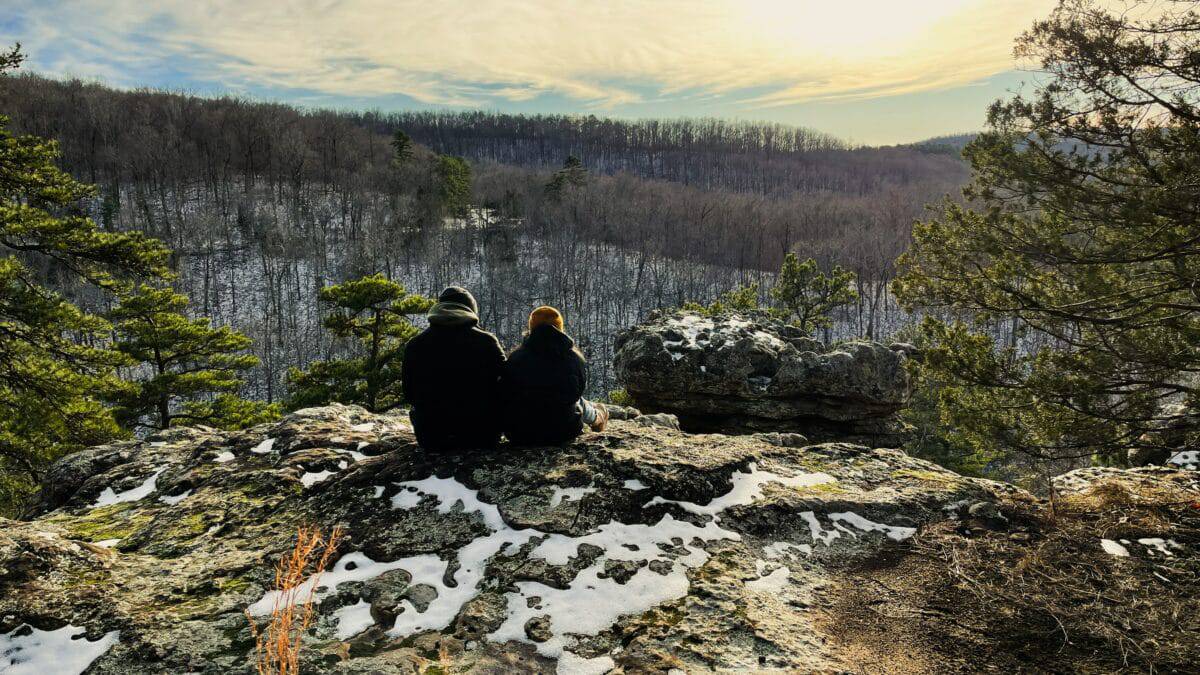
As you journey through Arkansas, you’ll discover the enchanting Mississippi Delta and the inviting embrace of the Gulf of Mexico in the lower regions. Let’s not forget the enchanting wetlands, from enchanting cypress swamps to serene slope wetlands.
The climate here sets the stage for abundant growth and evergreen landscapes. Arkansas enjoys a subtropical climate that celebrates all four glorious seasons. Summers are warm and inviting, springs are alive with vibrant blooms, autumn paints the landscape in vivid colors, and winter graces us with its gentle, snowy embrace.
Click below to jump to a section on animals in Arkansas:
Key Points
| Animal | Description | Habitat and Behavior | Physical Characteristics | Diet and Predators |
|---|---|---|---|---|
| White-Tail Deer | Arkansas’s official state mammal. | Pine forests, rainforests. Territorial, adaptable, agile. | Reddish-brown coat in summer, grayish-brown in winter. Large antlers for males. | Vegetation, twigs, buds, poplar, aspen, cactus, insects. Predators: coyotes, pumas, etc. |
| Elk | Around 500 elk in the Buffalo National River area. | Forests, grasslands, migratory. Active during spring migration. | Second-largest deer species globally, antlers for males. Dark winter manes. | Grass, leaves, tree bark. |
| Bald Eagle | USA’s national emblem. Conservation efforts rejuvenated the population. | Near water sources. Expert hunter. Diurnal. | 7-foot wingspan, 15 pounds. White head, brown body. | Fish, snakes, turtles, ducks, rabbits. Predators: humans (formerly endangered). |
| Ivory-billed Woodpecker | Critically endangered, large North American woodpecker. | Hardwood swamps, pine forests. Social and active during morning and late afternoon. | Black-purple plumage, long crest, sharp bill. | Beetle larvae, fruit, nuts. |
| Black Bear | A remarkable comeback in Arkansas after facing endangerment. | Forested areas, hibernation in dens. Omnivores. | Varies in color, typically black. Up to 7 feet long. | Fruit, nuts, herbs, honey, berries, fish, insects. |
| Nine-Banded Armadillo | Armored shell, adaptable, nocturnal, and insectivorous. | Diverse habitats. Nocturnal but active during cold, cloudy weather. | Armored shell, sensitive to temperature. Snout and claws for digging. | Insects, grubs, worms, ants, termites, tubers, amphibians, reptiles. Predators: coyotes, pumas, etc. |
| Mockingbird | Arkansas State Bird, known for mimicry. | Open grassy areas, gardens. Territorial and protective. | Light grey coat, white patches underneath. About 10 inches long. | Insects, ants, beetles, spiders, grasshoppers, seeds, berries. |
| 13-Lined Ground Squirrel | Found in open areas, forages in sunny conditions, and communicates through scented alarms. | Short grass areas, active during midday. Burrowers. | Striped pattern, erect posture. Short ears, thin tail. | Seeds, grass, clover. Predators: snakes, hawks. |
| Western Diamond-Backed Rattlesnake | Versatile habitats, active from April to October. | Desert, forest, plains. Diurnal. Coils during the day. | Diamond-shaped patterns on the back, triangular head. | Birds, lizards, gophers, rabbits, rats. Predators: eagles, hawks, coyotes, etc. |
| Alligator | Successful comeback in Arkansas. Bask in the sun, prefer wetland marshes, bayous. | Wetland marshes, bayous. Carnivores with powerful jaws. | Up to 12 feet, 1000 pounds. Long tail, webbed feet. | Invertebrates, fish, frogs, mammals. Predators: humans (formerly endangered). |
White-tail Deer

The white-tailed deer is the Arkansa’s official state mammal. They have reddish-brown coats in summer. Then, as winter arrives, the color turns a dull greyish-brown color. In summer and fall, the male deer have magnificent antlers, which grow every year and fall off in the wintertime.
They are called white tails because of the white underside of their tails and weigh around 300 pounds as adults. White-tailed deer are animals with incredible beauty and power, running up to 40 miles an hour, jumping 9 feet high, and even swimming 13 miles per hour.
White-tailed deer possess scent glands located between the two parts of their hooves on all four feet, a feature they use for communication and during the rutting season. While they boast exceptional eyesight and hearing, their sense of smell is their primary tool for detecting potential danger.
These adaptable creatures have a diverse diet, comprising vegetation like twigs, buds, poplar, aspen, sassafras, birch, and various shrubs. In desert regions, they even consume prickly pear cactus, drama, yucca, and other available plants. When winter brings scarcity, they may turn to conifers for sustenance.
White-tailed deer are primarily crepuscular, meaning they feed mainly before dawn and resume their grazing in the late afternoon until evening. They are inherently nervous and tend to be rather shy creatures.
Known for their swimming abilities, these deer are not hesitant to enter large lakes and streams when seeking refuge from predators. Although they are generally considered solitary animals, there have been instances of them grazing together in herds. White-tailed deer exhibit a remarkable capacity to adapt to various habitats, from dense forests to hammock swamps, farmlands, and even desolate areas, coexisting with a wide range of other animals in the diverse ecosystem of Arkansas.
Elk
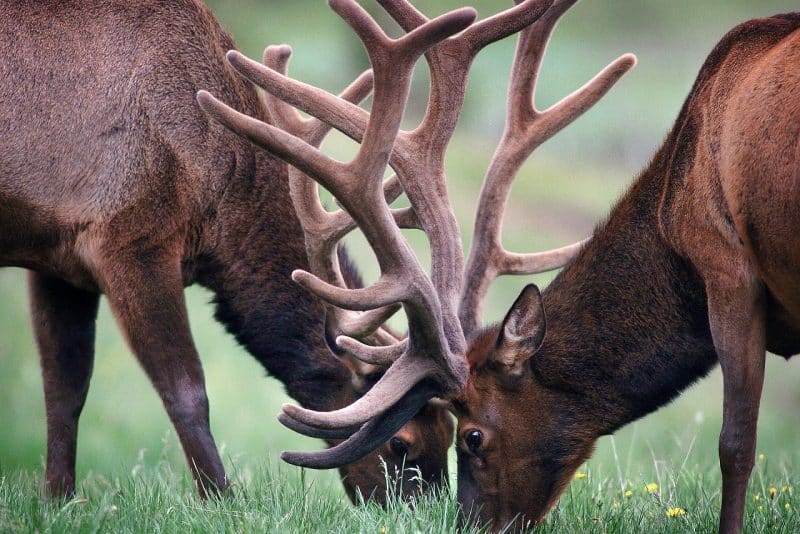
Arkansas boasts a hidden gem along the Buffalo National River – the Arkansas elk herds. While elk once thrived in the state, the pressures of increased human activity, hunting, and land development nearly pushed these magnificent creatures to the brink of extinction. However, thanks to the efforts of the Arkansas Game and Fish Commission (AGFC), elk have made a triumphant return to the Natural State.
Today, approximately 500 elk thrive in the Buffalo National River area, making autumn the ideal time to catch a glimpse of these majestic animals. Male elk, in particular, can sport antlers that weigh as much as 40 pounds, showcasing the native beauty of a species that was once on the brink of disappearing from Arkansas.
Elk are the second-largest species of deer globally, with only the moose surpassing them in size. During winter, both males and females develop a dark, impressive mane of hair around their necks, adding to their captivating allure in the Arkansas wilderness.
Elk love living in forests and woodlands, often in mountainous areas. Some species enjoy the grasslands and moorland areas. Usually, in spring, they like to migrate to higher places to get to the new growth to eat. Apart from leaves and grass, they eat tree bark as well. They can eat up to around 9.1 kg of plant matter each day.
Bald Eagle
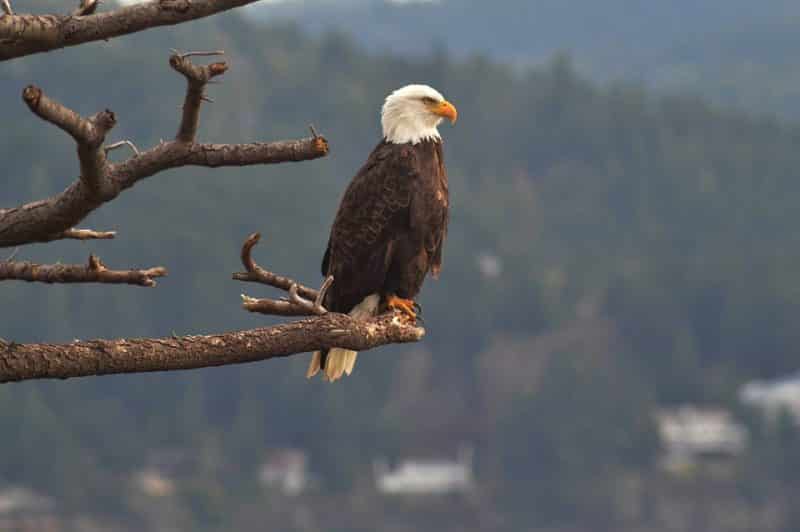
The bald eagle is recognized by its brown body, yellow hooked beak, and magnificent white head. Who wouldn’t identify this majestic bird – after all, it has been the national emblem of the USA since 1782! Nevertheless, its numbers declined long ago, and conservation efforts rejuvenated the population to continue to be the national bird of the US.
It has a wingspan of 7 feet and weighs 15 pounds. It likes to live near a constant water source, and its diet will consist of fish, snakes, turtles, ducks, rabbits, dead animals, and muskrats. They use their unique sense of sight and powerful talons to attack prey, swooping down at them.
They can easily reach speeds of up to 100 mph when they dive. Once they have captured their prey, they use that powerful hooked beak to pull out the animal’s flesh before eating it.
They can fly to about 10,000 ft. in the air, soaring for hours using the currents. Indeed they are a pleasure to watch! Bald eagles like to make their homes in giant trees near water and build impressive nests for their chicks. The nests are called eyries. They’ve got a few natural enemies, but fortunately, they are not on the endangered list anymore.
Explore the largest congregation of bald eagles with our dedicated article!
Ivory-billed Woodpecker
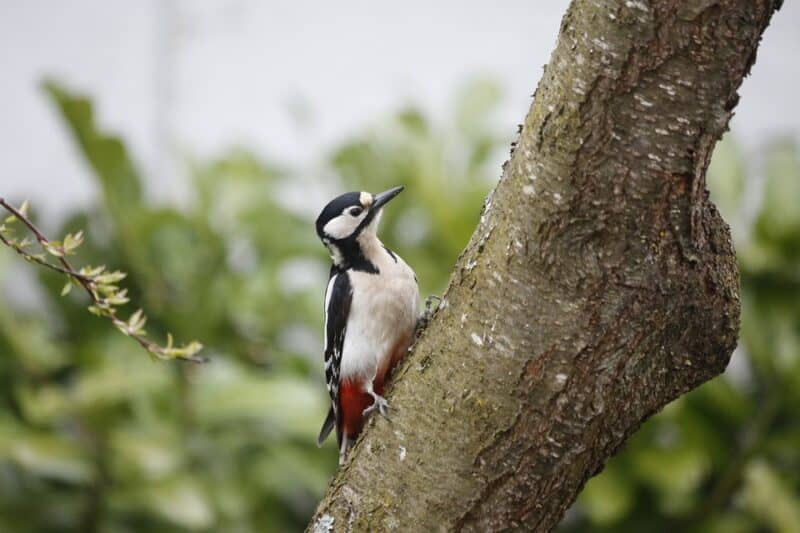
The ivory-billed woodpecker is the largest of the woodpeckers to be found north of Mexico. This one is the third-largest in the world of woodpeckers. Unfortunately, this unusual, unique bird is critically endangered because of the destruction of its forest habitat. It was thought to have become extinct in the middle of the 20th century. It resurfaced in, and intern Arkansas years back but has not been relocated.
They are considered swamp dwellers but are also found living on the tops of trees. Their plumage is predominantly shiny black-purple with white lines extending from the cheeks to their neck. They have a prominent crest with a strong, straight bill and a long hard-tipped barbed tongue. They love hardwood swamps as well as pine forests.
At night they spend their time in individual roost holes, leaving the roost holes at dawn to feed and engage in their activities. During midday, they remain inactive and then take up feeding activities in the late afternoon, returning to roost later. They use their massive bill to hammer and peel off the bark of trees. Woodpeckers are very social and often gather in groups to feed together on a single tree.
They might occasionally relocate to places with large amounts of dead wood because that might mean large numbers of beetle larvae, which they love to feed on. These birds are omnivores, preferring to eat beetle larvae, and they will also eat the fruit of pecans, acorns, southern magnolia, nuts, and poison ivy seeds. It is sometimes called the “Holy Grail bird” because it is scarce and elusive.
Black Bear
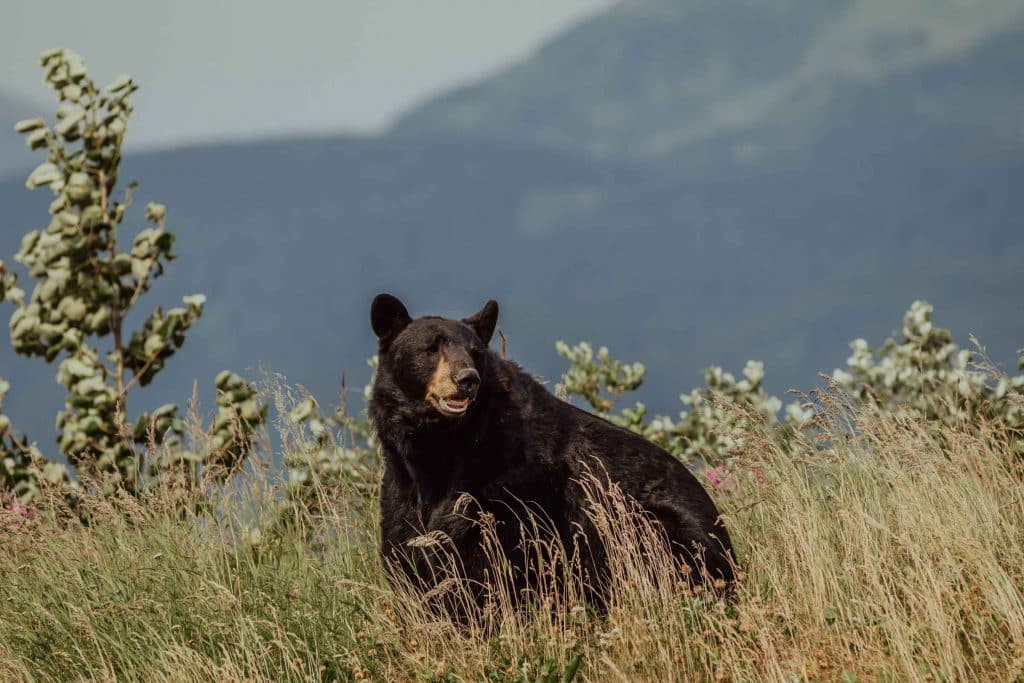
At least the black bears in Arkansas are not at dangerously low levels and have been making a good comeback in Arkansas. At one time, Arkansas was close to losing the one animal that had anchored its ecosystem for years, one of the state’s most valuable resources.
They like forested areas with thick ground cover that can supply them with fruits, vegetation, and nuts. During wintertime, they hibernate in dens. Being omnivores, most of their diet is plant–based. They feed on fruit, nuts, herbs, grasses, honey, berries, seeds, shoots, and vegetation.
They also eat fish, insects, small mammals, etc. Its coat is usually black, but don’t be surprised to see a dark brown one, cinnamon-colored, or even yellow-brown color. It can reach about 7 feet long from its nose to its tail, standing around 3 feet at the shoulders. It has small eyes, rounded ears, quite a long snout, and a short tail. The males can weigh around 300 pounds.
They love to catch the salmon in streams in the northern regains. They become active just before sunrise and take a couple of hours’ nap during the day, and they will go to sleep a couple of hours after sunset. Many bears become active at night to avoid people or even other bears.
The black bear is an efficient hibernator, sleeping for months without eating, urinating, defecating, or drinking. They are solitary animals and live alone, and they can run about 30 miles an hour and are good swimmers.
Nine-banded Armadillo

The nine-banded armadillo can live for about eight years. He weighs about 6.5 kg. He is medium-sized and has an armored shell covering his entire body. This consists of horny scales called “scutes.” It has a small head that ends at a point, its snout is long, and it has large, pointed ears. He has large thick claws on his front feet that help him to dig.
Meet the intriguing creature with a unique set of characteristics! This animal sports a minimal fur coat, making it acutely sensitive to temperature fluctuations. It’s a versatile athlete, excelling both in swimming and running. When confronted with a stream, it doesn’t hesitate to take the underwater route to reach the other side with ease. These critters are particularly fond of calling pine forests and rainforests their home.
For them, happiness resides in the shade of woodlands, as they loathe cold, dry environments. They have a preference for sandy and loamy soil, which serves as their playground for digging. Armadillos, known for their solitary lifestyle, are creatures of the night, but interestingly, they become day dwellers during overcast and chilly weather.
Don’t expect these animals to hibernate; they’re always on the move. Their vision may not be top-notch, but their sense of smell is second to none. If startled, they can leap an astonishing four feet! Armed with an insectivore’s diet, these curious diggers employ their snouts to unearth grubs, worms, ants, and termites. They also savor tubers and have a penchant for amphibians and reptiles.
But it’s not all sunshine and rainbows for our armored friends, as they have a lineup of predators, including coyotes, pumas, owls, alligators, bobcats, and even jaguars. Remarkably, armadillos serve as nature’s pest control squad by devouring certain agricultural nuisances. These creatures are a fascinating blend of quirks and qualities, making them a captivating addition to the animal kingdom.
You can read more about armadillos with our dedicated article!
Mockingbird
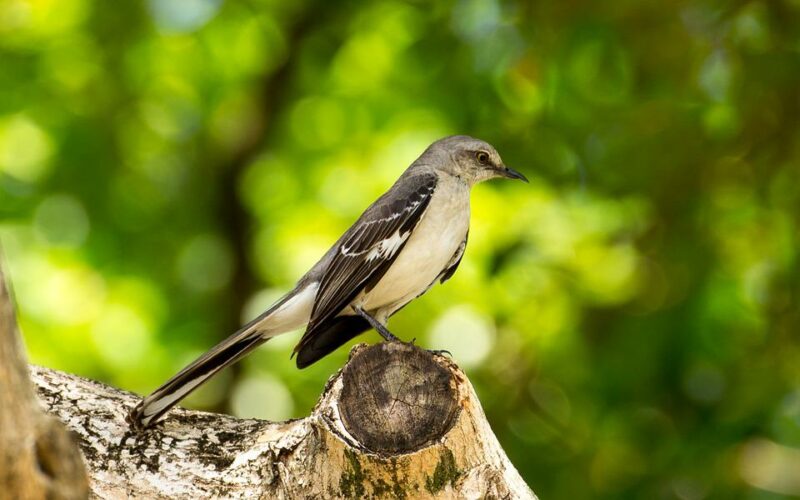
The mockingbird was adopted as the Arkansas State Bird in 1929. It’s no wonder mockingbird calls it, as it can imitate the songs of heaps of other birds. It is about ten inches long, including its long tail. It has a light grey coat with white underneath, and the wings and tail are a darker grey with white patches. Both males and females look the same. It is a super songbird, and it will often sing all night long!
The mockingbird is also known as a very fierce protector of its environment and its nest. It will swoop down on any predator that ventures too close to its protected area. The mockingbird likes open grassy areas where they search for food or thick thorny shrubs to hide in.
The male likes high perches where he can sing and take care of his territory. In gardens, if there are winter berries around, he loves to spend time in this garden. His diet includes insects, ants, beetles, spiders, grasshoppers, seeds, and berries.
Thirteen-lined Ground Squirrel
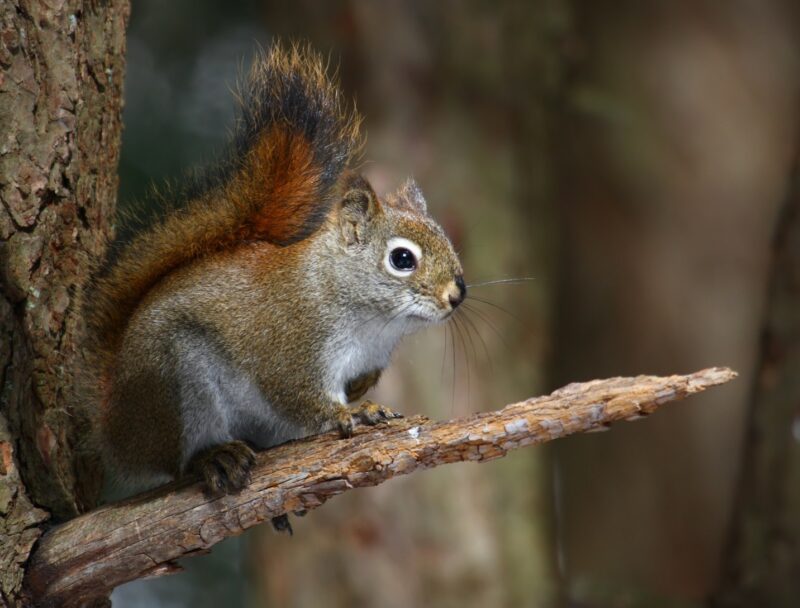
This cute little animal is found in many states of the USA, and Arkansas is one of them. The thirteen-lined ground squirrel loves open areas with short grass as its habitat. It prefers sandy or loamy soil because it can burrow there and likes to stay away from wooded areas. You will likely see it around golf courses, cemeteries, pastures, and the roadside.
It grows to about 300 mm long. It has alternate longitudinal dark brown and tan stripes extending from the nape of its neck to the base of its tail. The thirteen lines that give it its name consist of either seven broad dark brown stripes alternating with six thin tan bands or seven yellow stripes alternating with six dark brown stripes. It has short ears, and its tail is thin but bushy. It usually sits erect with its head pointed up. These little creatures live to be about seven years.
They are active at midday and on sunny days. They dig burrows to hibernate in – also for nesting. In winter, they put on weight by eating to prepare for the winter months of hibernation. They lose a lot of body weight through hibernation. Carnivores, snakes, and raptors prey on the thirteen-line ground squirrel.
They use scented alarm calls and secretions to communicate with other squirrels. When they meet other squirrels, they touch their noses and lips together. The name Spermophilus means “seed lover,” and it’s true; he loves the seeds of plants and will also enjoy eating crop species like wheat and corn, and it also enjoys grass, and clover. Their predators are snakes and hawks.
Western diamond-backed Rattlesnake
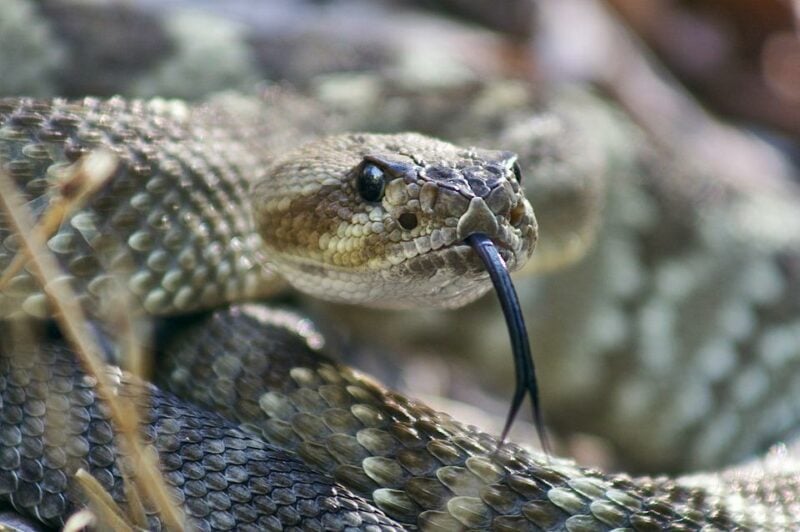
Western diamond-backed rattlesnakes, known for its distinct appearance, can be found in the Ouachita Mountains and the southwestern Ozark highlands of Arkansas. These snakes are particularly active from April to October, with a penchant for nocturnal activity during the summer months.
Characterized by their robust bodies, triangular-shaped heads, and two dark diagonal lines running from their eyes to their jaws, diamondback rattlesnakes derive their name from the diamond-shaped patterns that adorn their backs. They exhibit remarkable adaptability when it comes to habitat, thriving in deserts, plains, forests, rocky hillsides, and even coastal areas.
Their diet encompasses a variety of prey, including birds, lizards, gophers, rabbits, rats, and other small animals. Despite not being a primary food source for many predators, diamondback rattlesnakes face numerous threats from other animals considering them a danger. Some predators, like eagles, hawks, coyotes, bobcats, and foxes, may attempt to consume them.
During the scorching daytime hours, these snakes typically seek refuge coiled up in low-growing shrubs or under rocks, often utilizing burrows created by other animals. In winter, they retreat to caves or similar sheltered spots for hibernation. With a potential lifespan of around 15 years, diamondback rattlesnakes can grow up to 7 feet in length.
Alligator
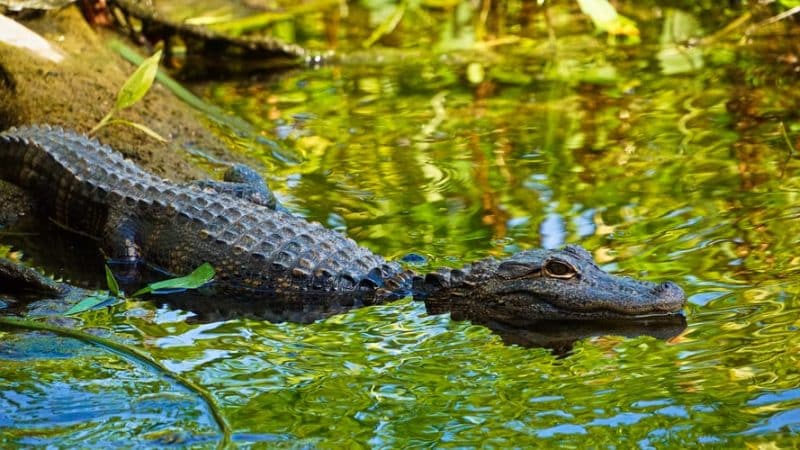
Alligators have been around in Arkansas for many years. Once, their numbers were depleted by unregulated hunting and habitat destruction.
They can’t handle the freezing weather. They won’t attack humans as long as you don’t provoke them or try and feed them. During the winter months, alligators don’t eat; they spend their days basking in the sun but don’t get warm enough to digest food. They bask in the sun for hours to trap the heat.
Arkansas Post’s wetland marshes, bayous, and low terrain offer the alligator excellent habitat. Alligators can also be found in the swamps of Millwood State Park. These animals are carnivores, eating invertebrates, fish, frogs, and mammals. These predators have sharp teeth and powerful jaws that can even crack a turtle’s shell! They also have two large teeth that stick out when their mouth is closed.
These large reptiles can grow to about 12 feet and weigh as much as 1000 pounds. Alligators have a long and powerful tail that helps propel them through the water and uses their webbed feet. They can live to be about 50 years old. However, they usually hibernate in winter and start rousing around April.
Summary of Animals and Wildlife of Arkansas
From the mountainous outbacks to the expanses of lowland, Arkansas hosts apex predators, exceptional bird life, alligators, and more wonders.
If you want to read more about all the types of wildlife you can encounter, check out Animals in Pennsylvania and Animals in Oklahoma next!
- Animals and Wildlife in Colorado - April 24, 2024
- Best Places to see Sloths - April 24, 2024
- Where to See Alligators in the Wild - April 24, 2024

